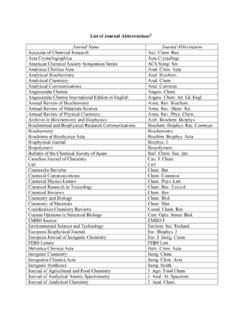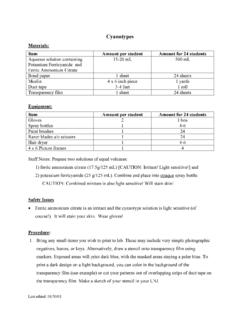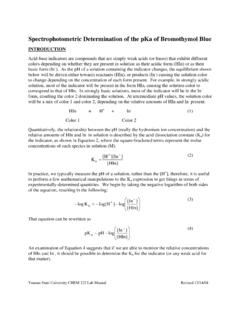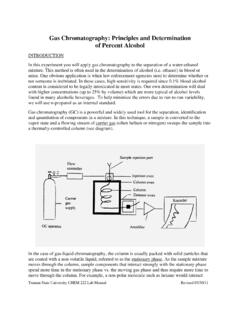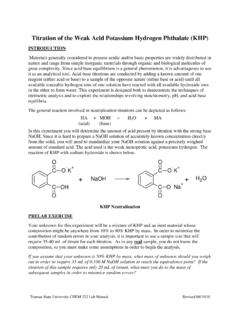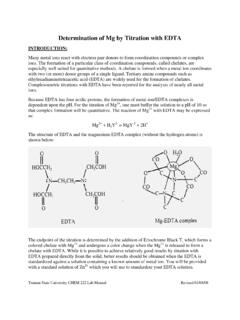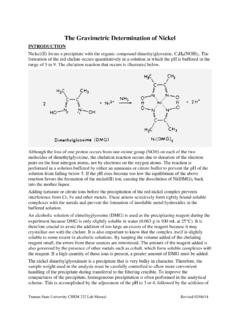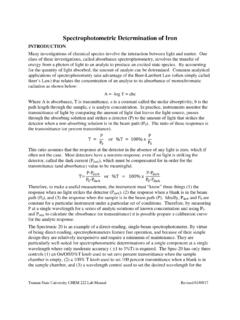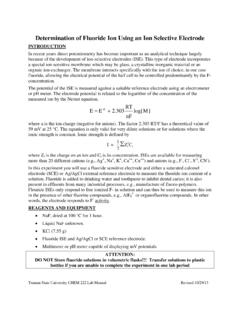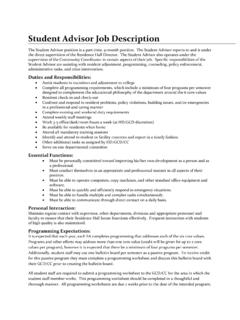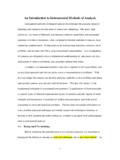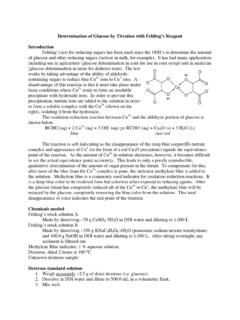Transcription of PAPER CHROMATOGRAPHY - Truman State …
1 PAPER CHROMATOGRAPHY CHROMATOGRAPHY is a technique that is used to separate and to identify components of a mixture. This analytical technique has a wide range of applications in the real world since many substances are mixtures of chemical compounds. In this lab, you will explore two applications of CHROMATOGRAPHY - identification of an unknown ink sample and the separation of food colorings. In PAPER CHROMATOGRAPHY , the sample mixture is applied to a piece of filter PAPER , the edge of the PAPER is immersed in a solvent, and the solvent moves up the PAPER by capillary action.
2 Components of the mixture are carried along with the solvent up the PAPER to varying degrees, depending on the compound's preference to be adsorbed onto the PAPER versus being carried along with the solvent. The PAPER is composed of cellulose to which polar water molecules are adsorbed, while the solvent is less polar, usually consisting of a mixture of water and an organic liquid. The PAPER is called the stationary phase while the solvent is referred to as the mobile phase. Performing a chromatographic experiment is basically a three-step process: 1) application of the sample, 2) "developing" the chromatogram by allowing the mobile phase to move up the PAPER , and 3) calculating Rf values and making conclusions.
3 In order to obtain a measure of the extent of movement of a component in a PAPER CHROMATOGRAPHY experiment, we can calculate an "Rf value" for each separated component in the developed chromatogram. An Rf value is a number that is defined as: distance traveled by component from application point Rf = ---------------------------------------- ------------ distance traveled by solvent from application point The distance traveled by the spot is measured to the MIDDLE of the spot. Pencil Mark Solvent FrontABRf = A/B INTRODUCTION Forensic chemistry, the profession popularized by TV's "Quincy" is the application of chemical techniques to law.
4 Many samples that are received in a crime laboratory are complex mixtures of chemical compounds and CHROMATOGRAPHY is often ideal for separating and identifying these components. One example of this is the identification of an unknown ink sample. Suppose the authenticity of a signature or the source of a ransom note is in question. Using PAPER CHROMATOGRAPHY , it is often possible to identify the source of the inks that were used and thereby provide strong evidence that can be used in the courtroom In the second part of the experiment, you will separate a mixture of three food colorings using "reverse-phase" CHROMATOGRAPHY .
5 In this type of CHROMATOGRAPHY , the stationary phase is a non-polar material and the mobile phase is relatively polar. You will use a commercial C18 cartridge, which contains very non-polar 18-carbon long chains as the stationary phase. The mobile phase will be water and/or isopropyl alcohol (IPA). Using CHROMATOGRAPHY PAPER strips AVOID EXCESSIVE HANDLING OF PAPER 1. The CHROMATOGRAPHY PAPER is cut in about x 10 cm strips. Along one of the shorter sides, draw a horizontal line in pencil (lead will not move) about cm from the edge of the strip.
6 This will be your base line , the starting line where the samples will be spotted. 2. Apply a dot of ink from each black felt tip pen on the baseline. Make sure dots are evenly spaced on the baseline and not too close to the edge. It may be helpful to use a pencil to mark the spots before placing the ink on the PAPER . See the diagram below. 3. Label each spot in pencil so that you know what each spot is. 4. Stand the PAPER in the eluting solution. Taping the top of the strips to the side of the beaker may be helpful.
7 Base Line 1 2 3 TECHNIQUES Using C18 cartridge 1. Remove the cartridge from the bottom of the syringe then remove the piston of the syringe. 2. Insert the LONGER END of the C18 cartridge snugly onto the syringe tip. Be careful to use the proper end and not put the cartridge on backwards. 3. Add solution as directed and insert the piston. 4. Flush solutions slowly through the cartridge. Faster is not better. 5. REMOVE CARTRIDGE BEFORE PULLING PLUNGER to add new solution to avoid pulling air backwards through the column.
8 6. The cartridge should be cleaned with a 1:1 mixture of water:IPA until all coloring is removed. Food coloring not removed may stain the column and make it less effective. The food coloring mixture will stain your skin and clothing. Handle with care. All of the solutions in this lab may be washed down the drain with water. I. Identification of Inks by PAPER CHROMATOGRAPHY A. This lab will be done as a collaboration between both lab pairs at a bench. 1. One lab pair will use 2 parts isopropanol to 1 part water as a solvent (labeled 2:1 IPA).
9 2. One lab pair will use 1 part isopropanol to 2 parts water as a solvent (labeled 1:2 IPA). B. Obtain a strip of CHROMATOGRAPHY PAPER about cm wide by 10 cm tall. Along one of the shorter sides, draw a horizontal line in pencil about cm from the edge of the strip. This will be your base line , the starting line where the samples will be spotted. Graphite will not be carried up the CHROMATOGRAPHY PAPER . This baseline will be used later in the calculations of Rf values.
10 C. Using the black felt tip pens, apply generous dots of ink on the baseline according to the diagram in the "TECHNIQUES" section. D. With a pencil, label each dot with the identity of the pen from which the ink came. E. Obtain a PAPER strip from your instructor that is marked with one of the three pens. This is the unknown ink sample that you must identify. F. Once your two strips are prepared, set up a developing chamber using a 400 ml beaker. SAFETY AND DISPOSAL EXPERIMENTAL PROCEDURE 1. Pour some of the developing solvent in the beaker, using only enough solvent to cover the bottom of the beaker (about 5-10 mL).
